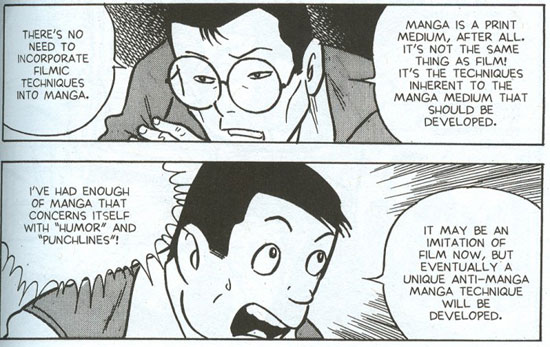Read This: A Drifting Life

I’ll confess: I’d been intimidated by the heft of Yoshihiro Tatsumi’s A Drifting Life (just over 850 pages!) since it showed up in my mailbox last spring. I knew I wanted to read it, but I just couldn’t work up the courage to start… until this weekend, when I finally plunged in to what turns out to be a real-life Japanese counterpart to The Amazing Adventures of Kavalier & Clay—a sprawling story about the corporate and creative squabbling of the manga boom of the late 1950s and early ’60s. It’s a coming of age story, a story about sibling rivalry, a love letter to the comics and movies of Tatsumi’s youth, a declaration of artistic intent… with a bunch more crammed in for good measure.
(Although, as you might guess by the artwork I selected above—borrowing from Comic Book Resources after attempts to scan my own version failed—the meta-argument about the aesthetic/artistic character of manga was especially interesting to me. Other readers, of course, might see it as pointless bickering that distracts from the plot about the artists getting jerked around by their publishers…)
And that’s just the story; the artwork is a great example of the manga technique of combining realistic illustration and caricature for emotional effect. While there’s nothing here quite as cartoonish as the characters in, say, Osamu Tezuka’s Buddha (except during those moments when Tatsumi is paying tribute to Tezuka), Tatsumi achieves a great deal of expressiveness while maintaining a simple, elegant line. So don’t let the bulk of this “graphic memoir” scare you off—once you get started, the pages can simply fly.
28 February 2010 | read this |
Read This: Refresh, Refresh
 Earlier this week, I learned that The Paris Review had put up a podcast of Benjamin Percy reading from an essay in the most recent issue, “Me vs. Animals.” And it reminded me that I’ve been wanting to recommend Refresh, Refresh, a comics adaptation of the title story from Percy’s second collection… or, rather, Danica Novgorodoff’s rendering of a screenplay by James Ponsoldt based on that short story into a graphic novel.
Earlier this week, I learned that The Paris Review had put up a podcast of Benjamin Percy reading from an essay in the most recent issue, “Me vs. Animals.” And it reminded me that I’ve been wanting to recommend Refresh, Refresh, a comics adaptation of the title story from Percy’s second collection… or, rather, Danica Novgorodoff’s rendering of a screenplay by James Ponsoldt based on that short story into a graphic novel.
(Longtime Beatrice readers may remember Percy’s guest appearance when his first collection was published.)
In either version, it’s a powerful story about the anger and frustration felt by teenage boys whose fathers have been sent to Iraq to fight in the war, and the lengths these boys will go to to fill up the empty spaces in their lives. Novgorodoff’s artwork adds an effective emotional subtext; as she told Comic Book Resources, “I wanted to show a clear progression, paralleling the increasing sense of violence with the passing of the seasons.” She also brings a bit more immediacy to the story; Percy’s prose version is exquisite, but it does have a sense (or it did to me) of reflection and retrospection, while the graphic novel feels more like an unfolding. But I encourage you to read them both and see what you think.

27 February 2010 | read this |

 Our Endless and Proper Work is my new book with Belt Publishing about starting (and sticking to) a productive writing practice.
Our Endless and Proper Work is my new book with Belt Publishing about starting (and sticking to) a productive writing practice. 
